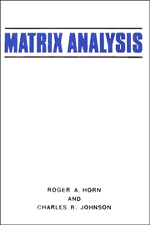Book contents
- Frontmatter
- Contents
- Preface
- Chapter 0 Review and miscellanea
- Chapter 1 Eigenvalues, eigenvectors, and similarity
- Chapter 2 Unitary equivalence and normal matrices
- Chapter 3 Canonical forms
- Chapter 4 Hermitian and symmetric matrices
- Chapter 5 Norms for vectors and matrices
- Chapter 6 Location and perturbation of eigenvalues
- Chapter 7 Positive definite matrices
- Chapter 8 Nonnegative matrices
- Appendices
- References
- Notation
- Index
Chapter 0 - Review and miscellanea
Published online by Cambridge University Press: 05 June 2012
- Frontmatter
- Contents
- Preface
- Chapter 0 Review and miscellanea
- Chapter 1 Eigenvalues, eigenvectors, and similarity
- Chapter 2 Unitary equivalence and normal matrices
- Chapter 3 Canonical forms
- Chapter 4 Hermitian and symmetric matrices
- Chapter 5 Norms for vectors and matrices
- Chapter 6 Location and perturbation of eigenvalues
- Chapter 7 Positive definite matrices
- Chapter 8 Nonnegative matrices
- Appendices
- References
- Notation
- Index
Summary
Introduction
The purpose of this chapter is to catalog briefly, without proof, a number of useful concepts and facts, many of which implicitly or explicitly underlie the material covered in the main portion of the book. Much of this material would be included, in some form, in an elementary course in linear algebra, but we also include a number of useful items that are not commonly found elsewhere or that do not easily fit into the subsequent structure. Thus, this section may serve the reader as a short review prior to beginning the book or as a convenient reference when necessary. We also use this chapter to set basic notation and give some definitions; thus, reference to it will also be useful for these purposes. We do assume that the reader is already familiar with the elementary concepts of linear algebra and with mechanical aspects of matrix manipulations, such as matrix multiplication and addition.
Vector spaces
Though generally implicitly, and not usually explicitly, involved in the treatment in this book, a vector space is the fundamental setting for matrix theory.
Scalar field.
Underlying a vector space is the field, or set of scalars, from which multiplication occurs. For our purposes, that underlying field will almost always be the real numbers R or the complex numbers C (see Appendix A) under the usual addition and multiplication, but Review and miscellanea it could be the rational numbers, the integers modulo a specified prime number, or some other field. When the field is unspecified, we use the symbol F.
- Type
- Chapter
- Information
- Matrix Analysis , pp. 1 - 32Publisher: Cambridge University PressPrint publication year: 1985
- 4
- Cited by



